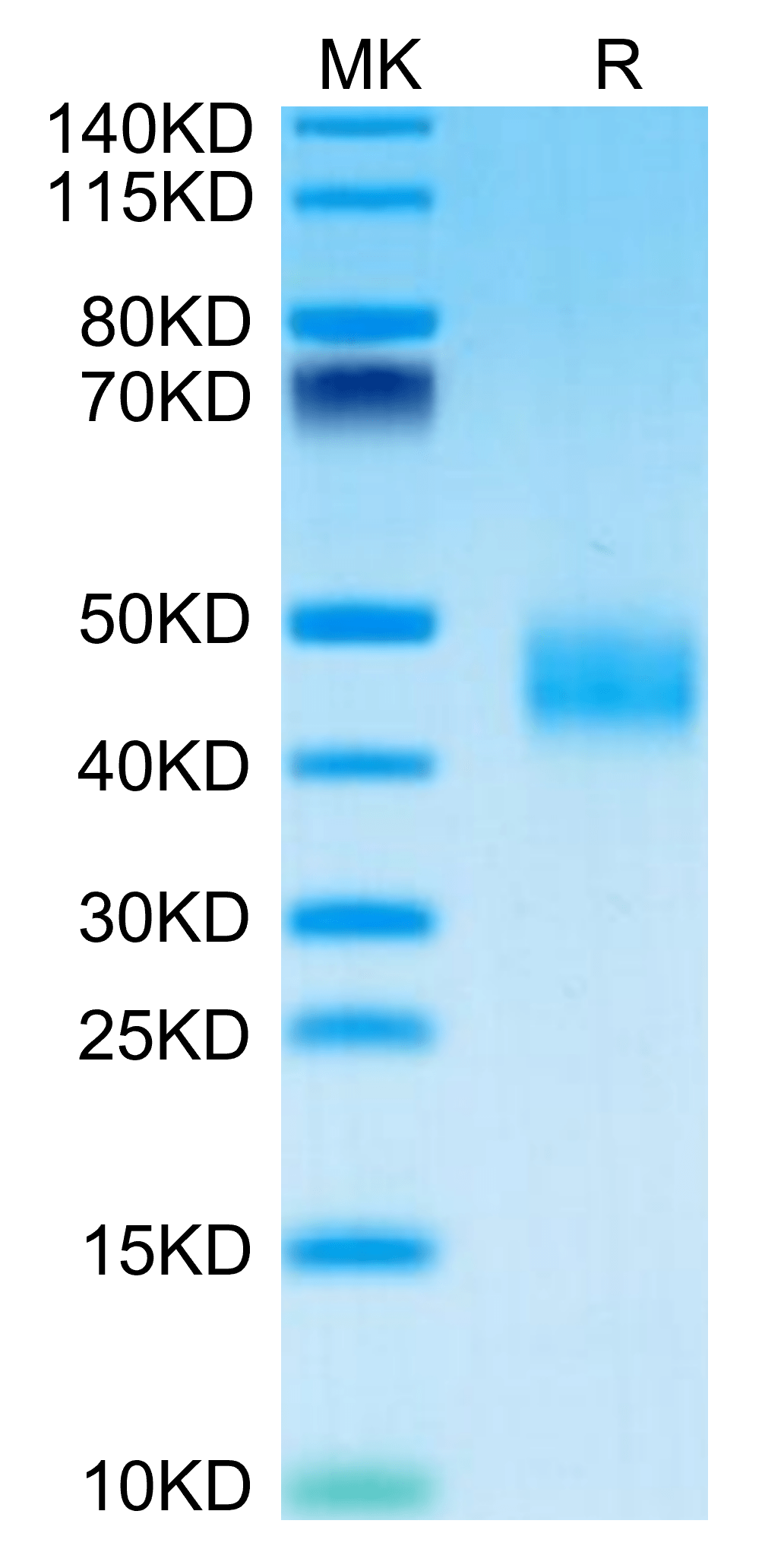| Weight | 1 lbs |
|---|---|
| Dimensions | 9 × 5 × 2 in |
| accession | P16110 |
| express system | HEK293 |
| product tag | C-His |
| purity | > 95% as determined by Tris-Bis PAGE |
| background | Galectin-3 (Gal-3) is a 30 kDa β-galactose, highly conserved and widely distributed intracellularly and extracellularly. Gal-3 has been demonstrated in recent years to be a novel inflammatory factor participating in the process of intravascular inflammation, lipid endocytosis, macrophage activation, cellular proliferation, monocyte chemotaxis, and cell adhesion. |
| molecular weight | The protein has a predicted MW of 28.5 kDa. Due to glycosylation, the protein migrates to 43-50 kDa based on Tris-Bis PAGE result. |
| available size | 100 µg, 500 µg |
| endotoxin | Less than 1EU per μg by the LAL method. |
Mouse Galectin 3 Protein 3422
$270.00 – $900.00
Summary
- Expression: HEK293
- Pure: Yes (SDS-PAGE)
- Amino Acid Range: Ala2-Ile264
Mouse Galectin 3 Protein 3422
| protein |
|---|
| Size and concentration 100, 500µg and lyophilized |
| Form Lyophilized |
| Storage Instructions Valid for 12 months from date of receipt when stored at -80°C. Recommend to aliquot the protein into smaller quantities for optimal storage. Please minimize freeze-thaw cycles. |
| Storage buffer Shipped at ambient temperature. |
| Purity > 95% as determined by Tris-Bis PAGE |
| target relevance |
|---|
| Galectin-3 (Gal-3) is a 30 kDa β-galactose, highly conserved and widely distributed intracellularly and extracellularly. Gal-3 has been demonstrated in recent years to be a novel inflammatory factor participating in the process of intravascular inflammation, lipid endocytosis, macrophage activation, cellular proliferation, monocyte chemotaxis, and cell adhesion. |
| Protein names Galectin-3 (Gal-3) (35 kDa lectin) (Carbohydrate-binding protein 35) (CBP 35) (Galactose-specific lectin 3) (IgE-binding protein) (L-34 galactoside-binding lectin) (Laminin-binding protein) (Lectin L-29) (Mac-2 antigen) |
| Gene names Lgals3,Lgals3 |
| Mass 10090Da |
| Function Galactose-specific lectin which binds IgE. May mediate with the alpha-3, beta-1 integrin the stimulation by CSPG4 of endothelial cells migration. Together with DMBT1, required for terminal differentiation of columnar epithelial cells during early embryogenesis. In the nucleus: acts as a pre-mRNA splicing factor. Involved in acute inflammatory responses including neutrophil activation and adhesion, chemoattraction of monocytes macrophages, opsonization of apoptotic neutrophils, and activation of mast cells. Together with TRIM16, coordinates the recognition of membrane damage with mobilization of the core autophagy regulators ATG16L1 and BECN1 in response to damaged endomembranes. |
| Catalytic activity BINDING 195..201; /ligand="a beta-D-galactoside"; /ligand_id="ChEBI:CHEBI:28034"; /evidence="ECO:0000250" |
| Subellular location Cytoplasm. Nucleus. Secreted. Note=Secreted by a non-classical secretory pathway and associates with the cell surface. Can be secreted; the secretion is dependent on protein unfolding and facilitated by the cargo receptor TMED10; it results in protein translocation from the cytoplasm into the ERGIC (endoplasmic reticulum-Golgi intermediate compartment) followed by vesicle entry and secretion. |
| Tissues The highest levels are found in activated macrophages. |
| Structure Probably forms homo- or heterodimers. Interacts with DMBT1 (By similarity). Interacts with CD6 and ALCAM. Forms a complex with the ITGA3, ITGB1 and CSPG4. Interacts with LGALS3BP, LYPD3, ZFTRAF1 and UACA. Interacts with TRIM16; this interaction mediates autophagy of damage endomembranes (By similarity). |
| Target Relevance information above includes information from UniProt accession: P16110 |
| The UniProt Consortium |
Publications
Publications
| pmid | title | authors | citation |
|---|---|---|---|
| We haven't added any publications to our database yet. | |||
Protocols
| relevant to this product |
|---|
Documents
| # | ||
|---|---|---|
| Please enter your product and batch number here to retrieve product datasheet, SDS, and QC information. | ||















